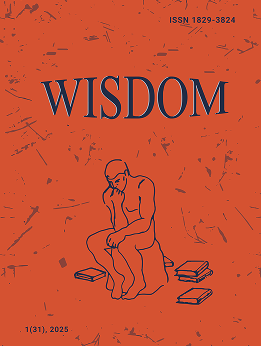Philosophical and Discursive Approaches to the Categorisation of Modal Meanings in Multimodal Texts
DOI:
https://doi.org/10.24234/wisdom.v3i2.782Keywords:
modus, plurisemioticity, functionality, indexicality, symbiosis of approaches, semiotically heterogeneous resourceAbstract
The question of overcoming barriers between the study of language and philosophical, immanent perception of the image and other aspects that formulate a coherent text is still open. A multimodal approach to understanding the news coverage strategy in the Telegram can reveal the discursive function and the multimodal perspective. One uses a combination of linguistic and philosophical approaches to analyze multimodal texts. This combination proves that the homogeneous use of the model of proving empirical reality employing philosophical and linguistic segments reveals the modulations. The article aims to explore the theoretical foundations of philosophical and discursive approaches to categorizing modal meanings in multimodal texts. The study results of the ideational architectonics of the 65 analysed multimodal posts on the Ukrainian Telegram channel “SUSPILNE NEWS” as of April 18, 2022 have pointed to a tendency of disconnection of categorical modalities. 19 multimodal texts out of 65 revealed a complete symbiosis of philosophical and linguistic modus operandi (the presence of all linguistic and extralinguistic resources, including video sequences), while 46 posts acted as monomodal tests. Regarding the number of “likes” and views, the posts with all extralinguistic and semiotically heterogeneous resources were more popular and, therefore, more exciting and easier to perceive.
Downloads
References
Caple, H. (2018). Analysing the multimodal text. In Corpus approaches to discourse (pp. 85-109). Routledge. https://doi.org/10.4324/9781315179346-5
Chia, A., & Chan, C. (2017). Re-defining ‘reading’ in the 21st century: Accessing multimodal texts. Beyond Words, 5(2), 98-105.
Dahlström, H. (2021). Students as digital multimodal text designers: A study of resources, affordanc-es, and experiences. British Journal of Educational Technology, 53(2), 391-407. https://doi.org/10.1111/bjet.13171
Dosenko, A. (2022). The phenomenon of the multimodal service media text of the communication platform. State and Regions. Series: Social Communications, 4(48), 97-101. Retrieved from http://www.zhu.edu.ua/journal_cpu/index.php/der_sc/article/view/864
Gu, Y. (2006). Multimodal text analysis: A corpus linguistic approach to situated discourse. Text & Talk - An Interdisciplinary Journal of Language, Discourse Communication Studies, 26(2), 127-167. https://doi.org/10.1515/text.2006.007
Hart, C., & Marmol Queralto, J. (2021). What can cognitive linguistics tell us about language-image relations? A multidimensional approach to intersemiotic convergence in multimodal texts. Cognitive Linguistics, 32(4), 529-562. https://doi.org/10.1515/cog-2021-0039
Hill, C., & Dorsey, J. (2019). Expanding the map of the literary canon through multimodal texts. In Handbook of the Changing World Language Map (pp. 1-13). Springer International Pub-lishing. https://doi.org/10.1007/978-3-319-73400-2_119-1
Jancsary, D., Höllerer, M. A., & Meyer, R. E. (2016). Critical analysis of visual and multimodal texts. Methods of Critical Discourse Studies, 3, 180-204. Retrieved from http://epub.wu.ac.at/6126/1/Dennis_etal_2016_SAGE-critical-analysis.pdf
Liu, J. (2013). Visual images interpretive strategies in multimodal texts. Journal of Language Teach-ing and Research, 4(6). https://doi.org/10.4304/jltr.4.6.1259-1263
Metros, S. E. (2008). The educator’s role in preparing visually literate learners. Theory into Practice, 47(2), 102-109. https://doi.org/10.1080/00405840801992264
Mukhametshina, D. R., Danilova, J. J., & Bubekova, L. B. (2020). Multimodal text: Authorís lin-guopragmatics and extralinguistic factors. Applied Linguistics Research Journal, 4(9), 112-117. https://doi.org/10.14744/alrj.2020.19981
Rajendra, T. D., & Kaur, S. (2022). Print-based multimodal texts: Using illustrated poems for generat-ing ideas and writing narratives. Studies in English Language and Education, 9(1), 278-298. https://doi.org/10.24815/siele.v9i1.21830
Savi?, V. (2020). Visual literacy for young language learners: Multimodal texts in content-based in-struction. In Handbook of Research on Cultivating Literacy in Diverse and Multilingual Classrooms (pp. 166-189). IGI Global.
Serafini, F. (2010). Reading multimodal texts: Perceptual, structural and ideological perspectives. Children’s Literature in Education, 41(2), 85-104. https://doi.org/10.1007/s10583-010-9100-5
Skaar, H. (2009). In defence of writing: A social semiotic perspective on digital media, literacy and learning. Literacy, 43(1), 36-42. https://doi.org/10.1111/j.1741-4369.2009.00502.x
Stepanyan, A., Manukyan, E., Tevosyan, L., & Ilyushina, M. (2022). Legal regime for scientific works in the digital age. WISDOM, 21(1), 117-122. https://doi.org/10.24234/wisdom.v21i1.625
Unsworth, L. (2014). Multiliteracies and metalanguage: Describing image/text relations as a resource for negotiating multimodal texts. In Handbook of research on new literacies (pp. 377-406). Routledge. https://doi.org/10.4324/9781410618894-24
Veum, A., Siljan, H. H., & Maagerø, E. (2020). Who am I? How newly arrived immigrant students construct themselves through multimodal texts? Scandinavian Journal of Educational Re-search, 1-16. https://doi.org/10.1080/00313831.2020.1788147
Wanselin, H., Danielsson, K., & Wikman, S. (2022). Analysing multimodal texts in science - A social semiotic perspective. Research in Science Education, 52(3), 891-907. https://doi.org/10.1007/s11165-021-10027-5
Yong, H. U., & Qing, Q. I. U. (2020). A study on verbal and image relations in multimodal texts from the perspective of intersemiotic complementarity. Canadian Social Science, 16(10), 50-56.
Downloads
Published
How to Cite
Issue
Section
Categories
License
Copyright (c) 2022 scientific journal WISDOM

This work is licensed under a Creative Commons Attribution-NoDerivatives 4.0 International License.
Creative Commons Attribution-Non-Commercial (CC BY-NC). CC BY-NC allows users to copy and distribute the article, provided this is not done for commercial purposes. The users may adapt – remix, transform, and build upon the material giving appropriate credit, and providing a link to the license. The full details of the license are available at https://creativecommons.org/licenses/by-nc/4.0/.















